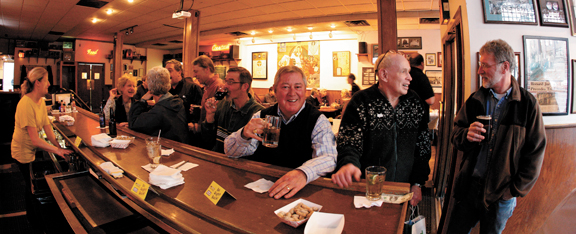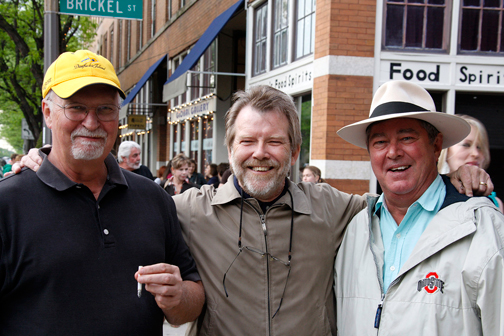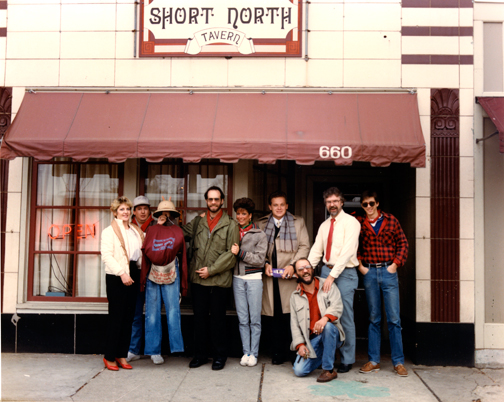
Columbus, Ohio USA
Return to Homepage www.shortnorth.com
Short North Tavern
Thirty-year-old bar aging gracefully
Urban experiment evolves into neighborhood epicenter
By Cynthia Bent Findlay
March 2011 Issue
See Also Article March 2000
Return to Features Index
Photos © Larry Hamill
Pioneer patron Joe Theibert holds a drink and smiles for the camera, comfortably ensconced among some after-work regulars. Standing in the Short North Tavern at midday, hours before opening time, you get the sense that each barstool is important to someone.
There is a lot of wood – booths, tables, liquor shelves. The wood floor is bleached smooth by a million shoes. Everywhere you look is the ephemera of the city, as if Columbus had a garage sale and John picked the best of it: black-and-white photos, an antique radio collection, sports league trophies. The north wall has been an art gallery for thirty years displaying the work of local aspirants, which somehow blends in with the exposed brick and the dart board all at the same time.
The Short North Tavern has been compared to Cheers, but it doesn’t have the Hollywood varnish. It’s exactly what you picture when you think “neighborhood bar,” but at the same time it’s genuine. You can tell that the old photos are of real people, with real lives and problems who probably sat, just like you, right here to dust off the day, to work through their problems and celebrate their joys.
“To me, it’s everything a neighborhood bar should be. It’s a place where regulars can go to escape the cares and obligations of their daily lives, and it’s also where strangers can go meet new people and become part of a family,” says Dennis Fiely, a long-time patron of the tavern.
It’s not just the décor that helps a stranger feel at home here, it’s the people, and for 30 years, John Allen has been the one to bring them in the doors.
“John is the lord of the manor. He comes in, checks with the staff to make sure everything’s OK, adjusts the thermostat, and sits in the same spot in the corner by the window and just kind of lords over his domain. In a good way,” says Fiely.
That’s pretty close to how Allen himself describes his role in the tavern, too – to make a good climate for everyone.
“When you walked through that door, everyone was equal, whether it was a VP of a corporation or a nail pounder, I wanted it to be that you became equal in here. So over time, the place has wound up as a real hodgepodge of different people,” Allen says.
Allen has been described in the past as “gruff,” a “big bear,” a “curmudgeon.” But none of that really does justice to the personality that shines out of his sharp blue eyes. Allen is both a good judge of character and a people person, and the tavern is a reflection of that.
“There are a lot of places closer to where I lived when I started coming, but I don’t think there was anyplace like the Short North Tavern, and I think it has a lot to do with John. He just always wanted everyone to be welcome,” says Kathy Henderson.
Henderson has been trekking down to the tavern for more than 20 years, first from the north end and then from Clintonville.
“A friend of mine said he’d found this perfect place, and he was totally right. Race, sex, whatever. There are people from all walks of life, men, women, different ethnicities, it’s just such a mix,” says Henderson. “I met so many friends right away,
I felt so comfortable, it’s not like any other place.”
“If someone new walks in, chances are they’re going to have a beer sitting in front of them very quickly. That’s what happened to me. I was pretty much a newbie,” says Fiely, a retired Columbus Dispatch writer and current freelancer.
Just as an aside, Fiely will freely tell you he’s probably sampled more than his share of local entertainment; as a result, not many of his anecdotes are, he says, fit to print. But the tavern has figured in those stories for more than twenty years.
“I can remember the night I became a regular. It was the night my wife of more than ten years sat me down at home and told me she wanted out of the marriage.
I was devastated. I had to get out of the house and I didn’t know where to go. I remembered this bar we occasionally went to and I thought, I’ll just go down there,” Fiely remembers.
“Some of the other regulars were in there. They put their arms around my shoulders, comforted me, bought me a beer, told me they’d all been through what I’m going through, to hang in there, it would all be all right, have another beer, and I’ve been going there ever since. That was about 1990,” Fiely says.
“You have to understand, no one ever brings anything small into a bar,” says Joe Theibert, who as one of the tavern’s first fixtures was there that night. Theibert, a Columbus native, ended up back in his hometown after a stint running a bar in San Francisco and in a good position to help Allen and his partner, Greg Carr, learn the ropes of running a bar.
Allen had moved to the Short North in 1973, buying and rehabbing an old Victorian home on Hubbard Avenue with his first wife. He was a jack of many trades, or more accurately, callings – he has worked for multiple social service agencies helping all kinds of populations, and for himself in consulting firms, in both city planning and as a social worker.
Allen will say he’s not really sure why he ended up buying a bar, but the record shows that the tavern has always been an outlet for his urban pioneering urges.
Many of the tavern’s early patrons fell into three groups, and Allen worked hard to make it that way. He intended the tavern to be the epicenter of the Short North’s renaissance from the very beginning.
There was the nascent arts community – artists and gallery folks; there was the local and state political crowd; and there were area small business people, the commercial homesteaders of the neighborhood. All, felt Allen, needed a gathering place that would attract the people who could turn the area around.
“My longstanding financial philosophy is that in the bar business particularly you can buy a bottle of Bud anywhere. I never thought I was selling that. I was selling a social environment,” Allen says.
For instance, he put some thought into who he’d use as bouncers – Ohio State wrestling team members.
“I didn’t want football players,” says Allen, who played his share of football at Muskingham College. “They’ll just as likely flatten you right there and you’d end up with a fight. Wrestlers will tie you in a knot, take you out, and unwrap you on the street.”
Allen says he used to scout out other bars to get a fix on who the neighborhood’s bad actors were.
High Street back then was the kind of neighborhood where unofficial and unsavory enforcers could be found, and Allen remembers that he wasn’t above using some of them to help convince some elements in the neighborhood who were scaring off customers to move out.
“We used music as a security tool. This area was country music then. I found I could control people who came in by what music we played. If someone I didn’t want walked in, I’d put on instrumental jazz. They’d give me a lecture on where I was before they left,” Allen says.
Allen ended up having to temporarily pull up stakes only a few months after the tavern’s opening and move down to Washington, D.C., taking a consulting contract because the bar wasn’t cranking out a living. Greg Carr, a Columbus-area native whom he’d met working for the city, ended up running and taking on part ownership of the tavern.
“We did share that sort of urban pioneering vision,” says Carr, who was finishing an OSU graduate degree in city planning. Carr ran the tavern while Allen was in Washington in exchange for a part-ownership position.
The aim was to create a funky, comfortable hangout, says Carr.
“We had barbershop quartets in there, a capalla groups, live Irish music on St. Patty’s day,” Carr says.
An early patron, Rick Petry, dean now at CCAD, provided free student art for the walls, kicking off the gallery wall tradition.
In the early days, Allen would ensure women always had someone to walk them safely back to their cars. He sponsored women’s darts teams, did his best to spruce up the ladies’ room, and in a dozen ways, worked for female clientele.
Henderson says the way that Allen did his best to make sure that women felt comfortable coming into the tavern alone is a part of what won her loyalty.
“I’m old enough to remember going into bars when I was a lot younger, and sometimes a male bartender wouldn’t even pay attention to you, unless you had a date. The tavern has never been like that,” she says. “He just wants everyone to be involved.”
The tavern slowly became cradle to a regular calendar of events. A yearly chili cookoff, an urban croquet event, and a legendary touch football game called the Wheezebowl were all planned at the bar, Fiely says.
Fiely points out that the Short North Tavern was the first business to use the term “Short North” in its name.
The trio of community-minded men behind the tavern’s birth and development:
John Allen, Greg Carr, and Joe Theibert.At a certain point, it’s hard to untangle the tavern’s story from the story of the Short North itself. Whether you’re talking to Allen, to Carr, or just about anyone else who was around through the 1980s, any talk about the early days of the tavern quickly morphs into a history lesson about the revitalization of the neighborhood.
Allen, looking around the bar, will point to Doo Dah Parade photos on the wall and note that Greg Carr plotted the very first Doo Dah Parade right here.
Or Carr will note that when the tavern opened, there were no street trees, no neat curbstones, let alone lighted arches.
Carr was already deeply immersed in neighborhood revitalization efforts when he took on the tavern. He co-founded the Neighborhood Design Assistance Center to provide free initial architectural design help for local property owners, to help jump-start the process of tying the area together with a visual identity. He also was one of the first presidents of the Near Northside Business Association, which would later become the Short North Business Association – and which Allen would also lead for some years.
Being independent business owners gave Allen and Carr much more freedom – and power – to work for change in the neighborhood.
“You could not be a pure advocate if you were getting paid by the city, by the people you’re supposed to be advocating against. You can develop trust on the part of people that you’re looking out for the best interests of the neighborhood. That’s a valuable person to have on your side, particularly if you know what you’re doing,” Carr says.
So the Short North became just as big a mission for the two as the tavern.
Among other achievements, Allen and Carr were both instrumental in landing an $11 million bond issue for infrastructure including an extensive street beautification project, giving the Short North the street trees and curbs it has today.
“John and my original dream was to have High Street become the most boldly lit entertainment strip in the Midwest, from East North Broadway all the way to Greenlawn,” Carr says.
Allen and Carr both point out that the Short North’s rebirth was the work of many, many hands, and they’re proud to be among the pioneers like Kent Rigsby, Ray Hanley and Sandy Wood.
The tavern has also become a renowned den for local Democrats, including Mayor Coleman from time to time, although opposing parties are reportedly just as welcome.
“Kasich was a reg there, and Mayor Reinhardt. And numerous republican candidates came by. A lot of affordable housing providers used it as a gathering place to discuss issues. The tavern became more than an arts and entertainment hangout, it became a subculture center of the urban experiment in all dimensions,” Carr says.
“There were a lot of political debates between left and right wingers. And it does end well. Eventually the conversation’s going to get back to sports or sex, two topics everyone can agree on. Even if you go in and announce you are a Penn State fan, that will just make you more appealing. Everyone will love giving you a hard time,” says Fiely.
For Allen and Carr and Theibert, the tavern really stands more for them as the living room (or maybe the rec room) of the Short North than any separate entity.
Allen might spend more time in the tavern these days than the rest of the Short North; you get the sense that he’s done pounding the nails outside.
“I don’t have the patience for meetings anymore,” he says.
Fall 1986. LtoR, Diana Schlairet, Larry Tuten, Cheryl, Scott Cebula, Beth Kinsey, Bob Bond, George Johnson, John Allen, Matt Phillips. (Photo courtesy John Allen) If you are able to swing the conversation back to the bar, you will hear that the tavern did actually move once. Allen took the opportunity to expand and purchased the building the tavern is currently in, moving it in 1989 just a few doors down from 660 N. High to 674 N. High. But it’s a testament to its nature that relocation seems to have been a brief blip, so much so that no one really remarks on it much or laments the old location.
Beyond a renovated kitchen and menu and a few flat screen TVs, the tavern really hasn’t changed much in 23 years.
What some call a stubborn refusal to change, Allen calls consistency, and he thinks it’s a big reason the tavern has remained a place to be.
“I spent a lot of time looking at places you could call institutions – they are predictable. You know what you’re going to get when you walk in. That’s what I set out to do, I wanted the tavern to be around for a long time,” Allen says.
The staff almost never changes, either. Helen, one of first bartenders, has been with Allen for twenty years, and has handled much of the day-to-day operation now for years. Other tenders have been around for a decade; few have a tenure of less than at least several years.
It’s true that the bar becomes more of a young person’s singles-type bar after about 10 p.m., with a crowd of OSU students and younger professional hipsters from the neighborhood. Happy hour is the time when the regulars who come every night can be found.
Allen and his wife bought a condo in Arizona not too long ago. He says he can’t take the Ohio winters anymore without a break, and says he’d like to spend more time there feeding his golf habit. But no one who knows him thinks that he’d ever be able to leave the tavern behind for any real length of time.
“I could have stayed in state government, played it safe. But my dad was a tool and die maker his whole life, married for 50 years, didn’t drink. I told him when we were talking about the bar that when you get to be an old guy, you won’t have many stories to tell. I’m going to have a bunch,” Allen says.Visit Facebook
Update correction 2019: Move from 660 to 674 N. High was in 1989, not 1998.
© 2011-2019 Short North Gazette, Columbus, Ohio. © All rights reserved.
Return to Homepage www.shortnorth.com


